-
Countries
-
Data and Analysis
-
Special Focus
-
Crisis Responses
Contact
ISSDTM@iom.int
Location
South Sudan
Activity
- Survey
- Community Perception
- Displacement Solutions
Period Covered
Jan 18 2024 -Feb 01 2024
This survey was administered in person with returnee heads of household in Renk to understand their plans for and potential concerns about (re)integration in their intended destinations in South Sudan.
Population Groups
Returnee (Previously Displaced Abroad)
Survey Methodology
Unit of Analysis Or Observation
Admin Area 2
Admin Area 3
Household
Type of Survey or Assessment
Household
Keywords
Geographical Scope Partial Coverage
Administrative boundaries with available data
The current dataset covers the following administrative boundaries
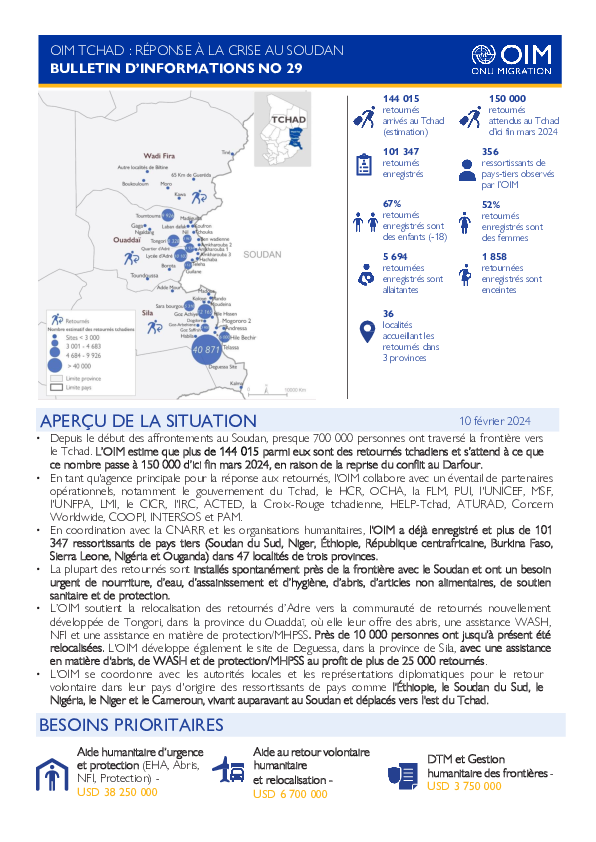
Contact
DTM Chad, dtmtchad@iom.int
Language
French
Location
Chad
Period Covered
Feb 10 2024
Feb 10 2024
Activity
- Mobility Tracking
- Event Tracking
• Depuis le début des affrontements au Soudan, presque 700 000 personnes ont traversé la frontière vers le Tchad. L’OIM estime que plus de 144 015 parmi eux sont des retournés tchadiens et s’attend à ce que ce nombre passe à 150 000 d’ici fin mars 2024, en raison de la reprise du conflit au Darfour.
• En tant qu'agence principale pour la réponse aux retournés, l'OIM collabore avec un éventail de partenaires opérationnels, notamment le gouvernement du Tchad, le HCR, OCHA, la FLM, PUI, l'UNICEF, MSF, l'UNFPA, LMI, le CICR, l'IRC, ACTED, la Croix-Rouge tchadienne, HELP-Tchad, ATURAD, Concern Worldwide, COOPI, INTERSOS et PAM.
• En coordination avec la CNARR et les organisations humanitaires, l'OIM a déjà enregistré et plus de 101 347 ressortissants de pays tiers (Soudan du Sud, Niger, Éthiopie, République centrafricaine, Burkina Faso, Sierra Leone, Nigéria et Ouganda) dans 47 localités de trois provinces.
• La plupart des retournés sont installés spontanément près de la frontière avec le Soudan et ont un besoin urgent de nourriture, d’eau, d’assainissement et d’hygiène, d’abris, d’articles non alimentaires, de soutien sanitaire et de protection.
• L’OIM soutient la relocalisation des retournés d’Adre vers la communauté de retournés nouvellement développée de Tongori, dans la province du Ouaddaï, où elle leur offre des abris, une assistance WASH, NFI et une assistance en matière de protection/MHPSS. Près de 10 000 personnes ont jusqu’à présent été relocalisées. L'OIM développe également le site de Deguessa, dans la province de Sila, avec une assistance en matière d'abris, de WASH et de protection/MHPSS au profit de plus de 25 000 retournés.
• L'OIM se coordonne avec les autorités locales et les représentations diplomatiques pour le retour volontaire dans leur pays d'origine des ressortissants de pays comme l'Éthiopie, le Soudan du
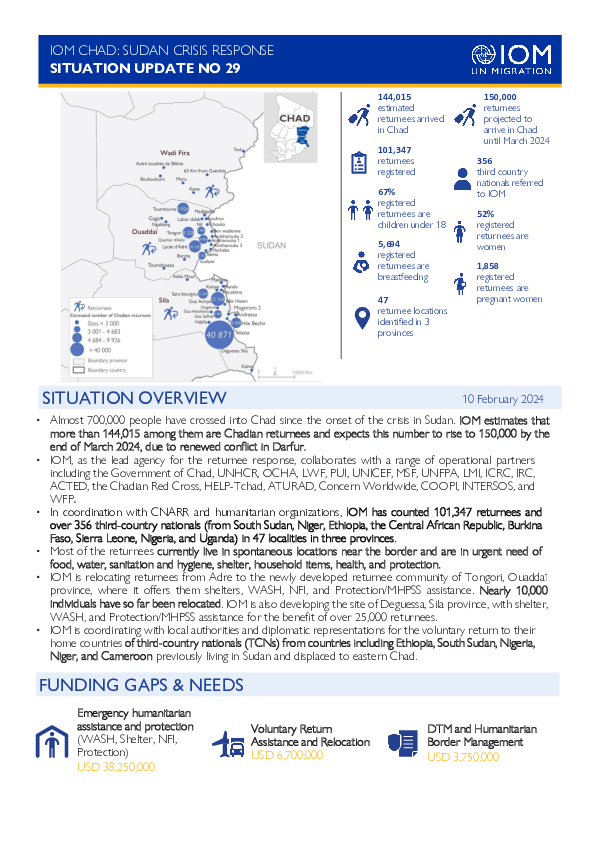
Contact
DTM Chad, dtmtchad@iom.int
Language
English
Location
Chad
Period Covered
Feb 12 2024
Feb 12 2024
Activity
- Mobility Tracking
- Event Tracking
• Almost 700,000 people have crossed into Chad since the onset of the crisis in Sudan. IOM estimates that more than 144,015 among them are Chadian returnees and expects this number to rise to 150,000 by the end of March 2024, due to renewed conflict in Darfur.
• IOM, as the lead agency for the returnee response, collaborates with a range of operational partners including the Government of Chad, UNHCR, OCHA, LWF, PUI, UNICEF, MSF, UNFPA, LMI, ICRC, IRC, ACTED, the Chadian Red Cross, HELP-Tchad, ATURAD, Concern Worldwide, COOPI, INTERSOS, and WFP.
• In coordination with CNARR and humanitarian organizations, IOM has counted 101,347 returnees and over 356 third-country nationals (from South Sudan, Niger, Ethiopia, the Central African Republic, Burkina Faso, Sierra Leone, Nigeria, and Uganda) in 47 localities in three provinces.
• Most of the returnees currently live in spontaneous locations near the border and are in urgent need of food, water, sanitation and hygiene, shelter, household items, health, and protection.
• IOM is relocating returnees from Adre to the newly developed returnee community of Tongori, Ouaddaï province, where it offers them shelters, WASH, NFI, and Protection/MHPSS assistance. Nearly 10,000 individuals have so far been relocated. IOM is also developing the site of Deguessa, Sila province, with shelter, WASH, and Protection/MHPSS assistance for the benefit of over 25,000 returnees.
• IOM is coordinating with local authorities and diplomatic representations for the voluntary return to their home countries of third-country nationals (TCNs) from countries including Ethiopia, South Sudan, Nigeria, Niger, and Cameroon previously living in Sudan and displaced to eastern Chad.
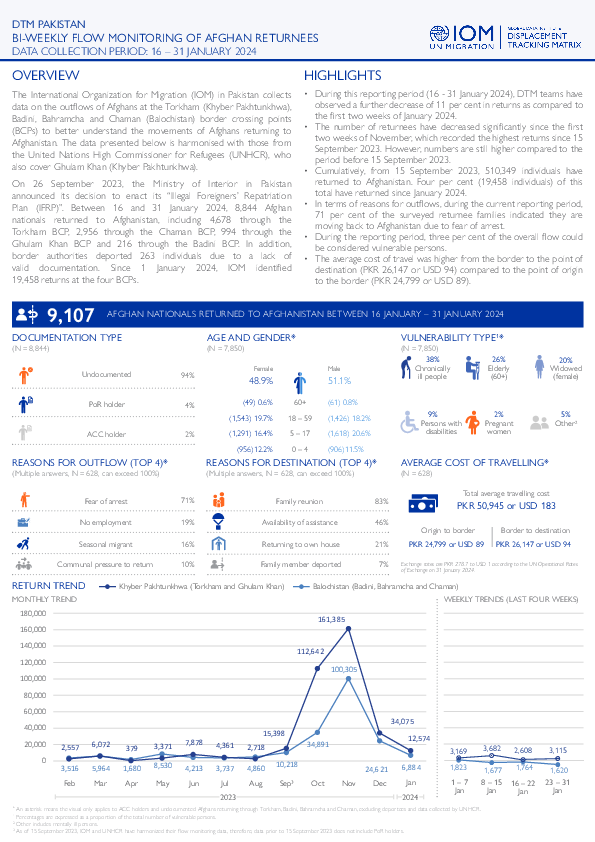
Contact
DTMPakistan@iom.int
Language
English
Location
Pakistan
Period Covered
Jan 16 2024
Jan 31 2024
Activity
- Flow Monitoring
On 26 September 2023, the Ministry of Interior in Pakistan announced its decision to enact its “Illegal Foreigners’ Repatriation Plan (IFRP)”. Between 16 and 31 January 2024, 8,844 Afghan nationals returned to Afghanistan, including 4,678 through the Torkham BCP, 2,956 through the Chaman BCP, 994 through the Ghulam Khan BCP and 216 through the Badini BCP. In addition, border authorities deported 263 individuals due to a lack of valid documentation. Since 1 January 2024, IOM identified 19,458 returns at the four BCPs.
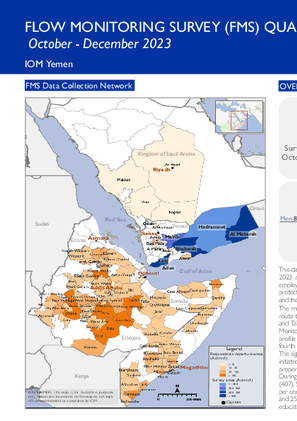
Contact
DTM Yemen, DTMYemen@iom.int
Language
English
Location
Yemen
Period Covered
Oct 01 2023
Dec 31 2023
Activity
- Survey
- Flow Monitoring Survey
- Flow Monitoring
This dashboard compiles flow monitoring survey (FMS) data collected in Yemen between October and December 2023 and provides an analysis of migrants’ demographic and socio-economic profiles, including education and employment backgrounds, reasons for leaving their country of origin or habitual residence, future travel intentions, protection and challenges faced during the journey. Also included are migrants’ highest level of education achieved and their labour status prior to moving.
The migration routes in the southern part of Yemen are categorized along two main routes: the south-eastern route towards Shabwah, Hadramawt, and Al Maharah governorates and the north-eastern route towards Lahj and Ta’iz governorates. Both routes are travelled by a large number of migrants each year. Through the Flow Monitoring Registry tool, which focuses on total numbers of migrants (as opposed to the more detailed migrant profile established through the FMS).
DTM recorded 4,853 migrants entered Yemen through the south in the fourth quarter of 2023. This figure represents a significant decrease (-68%) compared to the previous quarter. The significant and steady decrease observed since August is likely attributed to the ongoing joint military campaign initiated to combat smuggling and secure the coastline of Lahj, a well-known governorate for receiving the largest proportion of migrants. The campaign involved deploying troops, conducting raids, and establishing checkpoints.
During the fourth quarter of 2023, a total of 2,897 surveys were conducted. In Aden (435), Lahj (636), Ma’rib (407), Shabwah (609), Hadramawt (174) and Al Maharah (636). The overall number of surveys increased by seven per cent over the previous quarter. The majority of respondents were young male adults between the age of 17 and 25 (75%) searching for economic opportunities (97%), most of whom were single (94%), attained primary education or less (61%), were currently unemployed (95%) and departed from rural areas (67%).
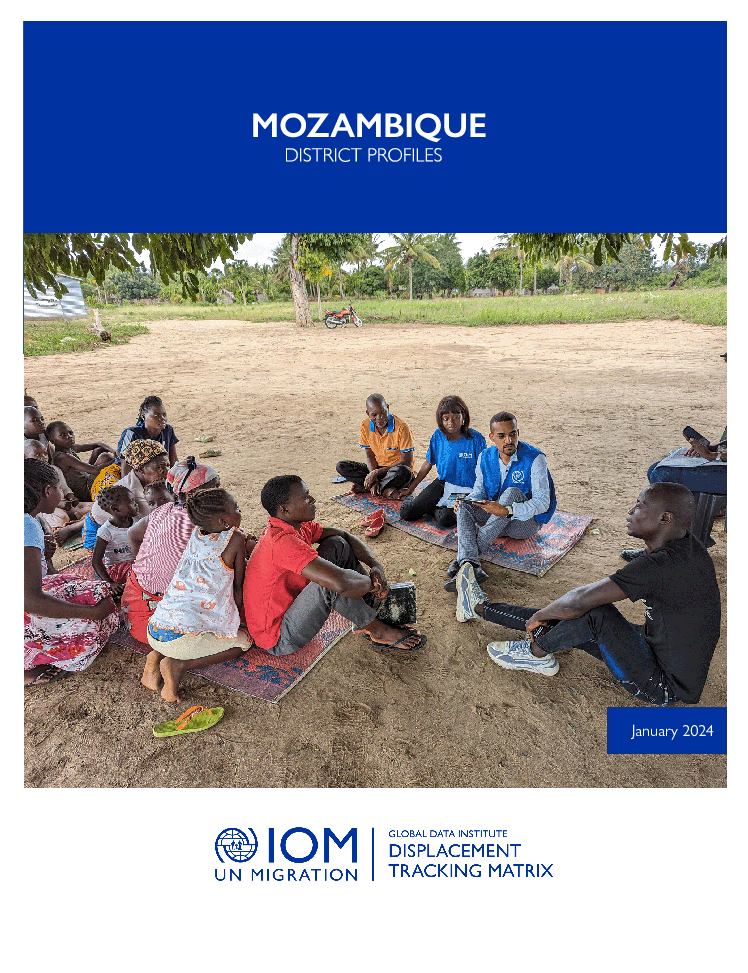
Contact
DTM Mozambique, DTMMozambique@iom.int
Language
English
Location
Mozambique
Period Covered
Dec 05 2023
Dec 29 2023
Activity
- Mobility Tracking
This district profile is part of our comprehensive analysis in the 20th round of Mobility Tracking Assessments. This one-pager per district succinctly summarizes the situation of IDPs in a specific district, focusing on IDPs population trends, demographics, origins, living conditions, and their most pressing needs.
Contact
dtmlebanon@iom.int
Location
Lebanon
Activity
- Mobility Tracking
- Baseline Assessment
Period Covered
Oct 10 2023 -Feb 13 2024
Since October 8 there has been an increase in cross-border incidents between Israel and Lebanon, resulting in the displacement of people both within the South and elsewhere within the country. Since October 10, the Displacement Tracking Matrix (DTM) has been conducting the daily monitoring of population movements. The objective of the exercise is to inform preparedness and response planning.
Population Groups
IDPs
Survey Methodology
Unit of Analysis Or Observation
Admin Area 2
Admin Area 3
Type of Survey or Assessment
Key Informant
Keywords
Geographical Scope Full Coverage
Administrative boundaries with available data
The current dataset covers the following administrative boundaries

Contact
DTM Nigeria, iomnigeriadtm@iom.int
Language
English
Location
Nigeria
Period Covered
Feb 05 2024
Feb 11 2024
Activity
- Mobility Tracking
- Event Tracking
Between 05 and 11 February 2024, a total of 3,260 new arrivals were recorded at locations in Adamawa and Borno states. The new arrivals were recorded at locations in Askira/Uba, Bama, Gwoza, Kaga, Monguno and Ngala Local Government Areas (LGAs) of the most conflict-affected Borno State, in Fufore, Girei, Gombi, Guyuk, Hong, Lamurde, Madagali, Maiha, Michika, Mubi North, Mubi South, Numan, Song, Yola North and Yola South LGAs of Adamawa State and Busari, Damaturu, Nguru, Potiskum and Tarmuwa LGAs of Yobe State.
ETT assessments identified the following movement triggers: fear of attack (1,490 individuals or 46%), poor living conditions (549 individuals or 17%), family re-unification (442 individuals or 14%), improved security (278 individuals or 8%), seasonal farming (183 individuals or 6%), access to humanitarian support (180 individuals or 5%), military operations (101 individuals or 3%) and attacks (37 individuals or 1%).

Contact
DTM Nigeria, iomnigeriadtm@iom.int
Language
English
Location
Nigeria
Period Covered
Jan 29 2024
Feb 04 2024
Activity
- Mobility Tracking
- Event Tracking
Between 29 January and 04 February 2024, a total of 1,578 new arrivals were recorded at locations in Adamawa and Borno states. The new arrivals were recorded at locations in Askira/Uba, Bama, Biu, Chibok, Damboa, Dikwa, Gubio, Gwoza, Kaga, Konduga, Kwaya/Kusar, Monguno and Ngala Local Government Areas (LGAs) of the most conflict-affected Borno State and in Fufore, Girei, Gombi, Guyuk, Hong, Lamurde, Madagali, Maiha, Mayo-Belwa, Michika, Mubi North, Numan, Song, Yola North and Yola South LGAs of Adamawa State.
ETT assessments identified the following movement triggers: poor living conditions (264 individuals or 17%), seasonal farming (253 individuals or 16%), military operations (239 individuals or 15%), family re-unification (229 individuals or 14%), access to humanitarian support (225 individuals or 14%), improved security (182 individuals or 12%), fear of attack (154 individuals or 10%) and attacks (32 individuals or 2%).

Contact
DTM Nigeria, iomnigeriadtm@iom.int
Language
English
Location
Nigeria
Period Covered
Jan 22 2024
Jan 28 2024
Activity
- Mobility Tracking
- Event Tracking
Between 22 and 28 January 2024, a total of 2,198 new arrivals were recorded at locations in Adamawa and Borno states. The new arrivals were recorded at locations in Askira/Uba, Bama, Damboa, Dikwa, Gubio, Gwoza, Hawul, Kaga, Kala/Balge, Mafa, Monguno and Ngala Local Government Areas (LGAs) of the most conflict-affected Borno State and in Fufore, Ganye, Girei, Gombi, Guyuk, Hong, Lamurde, Madagali, Maiha, Mayo-Belwa, Michika, Mubi North, Mubi South, Numan, Song, Yola North and Yola South LGAs of Adamawa State.
ETT assessments identified the following movement triggers: family re-unification (532 individuals or 24%), poor living conditions (517 individuals or 24%), access to humanitarian support (321 individuals or 15%), improved security (310 individuals or 14%), fear of attack (214 individuals or 10%), seasonal farming (182 individuals or 8%), military operations (113 individuals or 5%) and attacks (7 individuals or <1%).